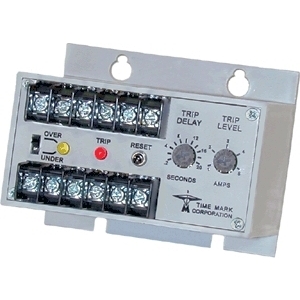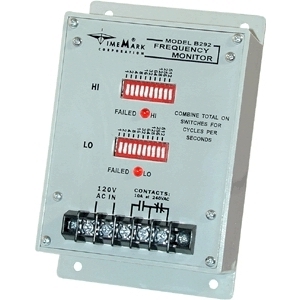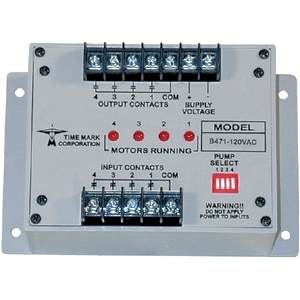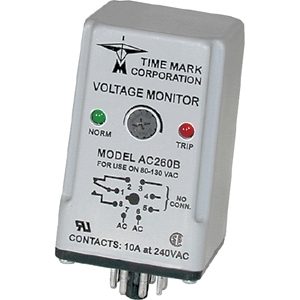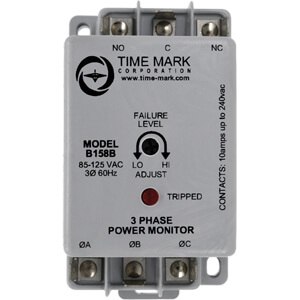-
A2732
Single Phase Over/Under Current Monitor1 - 5ASelect optionsThe Model 2732 Single Phase Current Monitor is designed to continuously monitor single-phase AC current. It consists of a solid-state sensing circuit driving an internal electromechanical relay. The Model 2732 has two operating modes: over-current sensing or under-current sensing. The operating mode is selected by means of a slide switch on the monitor. When operating voltage is applied, and the current level is correct according to the operating mode, the relay will energize. A fault condition will cause the OVER/UNDER LED on the monitor to illuminate, and the trip delay will begin. If correct current is restored, the relay remains energized. If current is not restored during the delay period, the relay will de-energize and the red TRIP indicator will illuminate. The Model 2732 has three reset configurations: automatic, manual (add jumper), or manual remote (add switch). The standard model, as provided, will reset automatically.
-
A292
Frequency MonitorSelect optionsThe Model 292 Frequency Monitor is designed to monitor power line frequency. It is intended for systems where line frequency variations will cause improper operation of electrical equipment. A solid-state sensing circuit drives an internal electromechanical relay which is energized when the line frequency is correct. Operating power is drawn from the same line being monitored.
The Model 292 is set to the over and/or under frequency trip points using ten binary-coded switches. A frequency variation outside the trip points causes the internal relay to drop out and an appropriate LED indicator to illuminate.
Applications for the Model 292 include stand-by power plants, portable power supplies, and windmill generators.
-
A471
Multi-Stage AlternatorSelect optionsThe Model 471 Multi-Stage Alternator is designed to control the operating sequence of multi-stage pumping systems. it can also be used to maintain the desired level of pressure on air compressor systems. Four PUMP SELECT DIP switches located on the front panel allow the alternator to control a single-pump, two-pump, three-pump or four-pump system. Only one switch needs to be set for the total number of pumps in the system. The Model 471 will assure that only the necessary pumps are operating, and that the run time for each pump is approximately equal. Pumps are sequenced first-on and first-off. If the pumping demand requires only one pump at a time, the alternator will start the next pump in sequence each time an input switch is closed. Input switches may be float switches, pressure switches, flow switches, etc. , as required by the application.
Potential uses for the Model 471 include water supply systems, sewage disposal plant systems, storage tank filling systems, air compressor systems, irrigation and water recycling systems.
-
AC260B-160-250
Over or Under Voltage MonitorSelect optionsThe Model 260 Voltage Sensor is a single set-point voltage sensor. Input voltages above the set-point cause the output contacts to energize (contacts 1 & 8 closed). Input voltages below the set-point cause the output contacts to de-energize (contacts 1 & 2 closed). The dead band between pull-in and drop-out is less than 2%.
The standard unit has a screwdriver, or fingertip adjustable set-point range of approximately 35%. of the maximum voltage. This device can also be provided with a factory calibrated trip point.
AC versions of the Model 260 Voltage Sensor are not frequency sensitive, and may be used in systems from 50 Hz to 400 Hz. DC models are not polarity sensitive. This device requires a standard 8-pin socket, such as Time Mark’s Model 51×120.
-
AC260B-215-290
Over or Under Voltage MonitorSelect optionsThe Model 260 Voltage Sensor is a single set-point voltage sensor. Input voltages above the set-point cause the output contacts to energize (contacts 1 & 8 closed). Input voltages below the set-point cause the output contacts to de-energize (contacts 1 & 2 closed). The dead band between pull-in and drop-out is less than 2%.
The standard unit has a screwdriver, or fingertip adjustable set-point range of approximately 35%. of the maximum voltage. This device can also be provided with a factory calibrated trip point.
AC versions of the Model 260 Voltage Sensor are not frequency sensitive, and may be used in systems from 50 Hz to 400 Hz. DC models are not polarity sensitive. This device requires a standard 8-pin socket, such as Time Mark’s Model 51×120.
-
AC260B-380-480
Over or Under Voltage MonitorSelect optionsThe Model 260 Voltage Sensor is a single set-point voltage sensor. Input voltages above the set-point cause the output contacts to energize (contacts 1 & 8 closed). Input voltages below the set-point cause the output contacts to de-energize (contacts 1 & 2 closed). The dead band between pull-in and drop-out is less than 2%.
The standard unit has a screwdriver, or fingertip adjustable set-point range of approximately 35%. of the maximum voltage. This device can also be provided with a factory calibrated trip point.
AC versions of the Model 260 Voltage Sensor are not frequency sensitive, and may be used in systems from 50 Hz to 400 Hz. DC models are not polarity sensitive. This device requires a standard 8-pin socket, such as Time Mark’s Model 51×120.
-
AC260B-80-130
Over or Under Voltage MonitorSelect optionsThe Model 260 Voltage Sensor is a single set-point voltage sensor. Input voltages above the set-point cause the output contacts to energize (contacts 1 & 8 closed). Input voltages below the set-point cause the output contacts to de-energize (contacts 1 & 2 closed). The dead band between pull-in and drop-out is less than 2%.
The standard unit has a screwdriver, or fingertip adjustable set-point range of approximately 35%. of the maximum voltage. This device can also be provided with a factory calibrated trip point.
AC versions of the Model 260 Voltage Sensor are not frequency sensitive, and may be used in systems from 50 Hz to 400 Hz. DC models are not polarity sensitive. This device requires a standard 8-pin socket, such as Time Mark’s Model 51×120.
-
AC260BM-160-250
Over or Under Voltage MonitorSelect optionsThe Model 260 Voltage Sensor is a single set-point voltage sensor. Input voltages above the set-point cause the output contacts to energize (contacts 1 & 8 closed). Input voltages below the set-point cause the output contacts to de-energize (contacts 1 & 2 closed). The dead band between pull-in and drop-out is less than 2%.
The standard unit has a screwdriver, or fingertip adjustable set-point range of approximately 35%. of the maximum voltage. This device can also be provided with a factory calibrated trip point.
AC versions of the Model 260 Voltage Sensor are not frequency sensitive, and may be used in systems from 50 Hz to 400 Hz. DC models are not polarity sensitive. This device requires a standard 8-pin socket, such as Time Mark’s Model 51×120.
-
AC260BM-215-290
Over or Under Voltage MonitorSelect optionsThe Model 260 Voltage Sensor is a single set-point voltage sensor. Input voltages above the set-point cause the output contacts to energize (contacts 1 & 8 closed). Input voltages below the set-point cause the output contacts to de-energize (contacts 1 & 2 closed). The dead band between pull-in and drop-out is less than 2%.
The standard unit has a screwdriver, or fingertip adjustable set-point range of approximately 35%. of the maximum voltage. This device can also be provided with a factory calibrated trip point.
AC versions of the Model 260 Voltage Sensor are not frequency sensitive, and may be used in systems from 50 Hz to 400 Hz. DC models are not polarity sensitive. This device requires a standard 8-pin socket, such as Time Mark’s Model 51×120.
-
AC260BM-380-480
Over or Under Voltage MonitorSelect optionsThe Model 260 Voltage Sensor is a single set-point voltage sensor. Input voltages above the set-point cause the output contacts to energize (contacts 1 & 8 closed). Input voltages below the set-point cause the output contacts to de-energize (contacts 1 & 2 closed). The dead band between pull-in and drop-out is less than 2%.
The standard unit has a screwdriver, or fingertip adjustable set-point range of approximately 35%. of the maximum voltage. This device can also be provided with a factory calibrated trip point.
AC versions of the Model 260 Voltage Sensor are not frequency sensitive, and may be used in systems from 50 Hz to 400 Hz. DC models are not polarity sensitive. This device requires a standard 8-pin socket, such as Time Mark’s Model 51×120.
-
AC260BM-80-130
Over or Under Voltage MonitorSelect optionsThe Model 260 Voltage Sensor is a single set-point voltage sensor. Input voltages above the set-point cause the output contacts to energize (contacts 1 & 8 closed). Input voltages below the set-point cause the output contacts to de-energize (contacts 1 & 2 closed). The dead band between pull-in and drop-out is less than 2%.
The standard unit has a screwdriver, or fingertip adjustable set-point range of approximately 35%. of the maximum voltage. This device can also be provided with a factory calibrated trip point.
AC versions of the Model 260 Voltage Sensor are not frequency sensitive, and may be used in systems from 50 Hz to 400 Hz. DC models are not polarity sensitive. This device requires a standard 8-pin socket, such as Time Mark’s Model 51×120.
-
B158B
3-Phase MonitorSelect optionsThe Model 158 continuously monitors 3-phase power lines for abnormal conditions. When properly adjusted, the Model 158 monitor will detect phase loss on a loaded motor even when regenerated voltage is present.
This device consists of a solid-state voltage and phase-angle sensing circuit, driving an electro-mechanical relay. When correct voltage and phase rotation are applied, the internal relay will energize. A fault condition will de-energize the relay. When the fault is corrected, the monitor will automatically reset.
The Model 158 does not require a neutral connection, and can be used with Wye or Delta systems. Four versions cover 120V, 208/240V, 480V (60Hz) and 380V (50Hz). Voltage ranges are sufficient to allow for proper adjustment to existing conditions. A front-mounted LED failure indicator is provided.
The R versions of the Model 158 monitor have an additional LED indicator for RESTART and a 5 minute short cycle timer, to delay restarting the motor.

